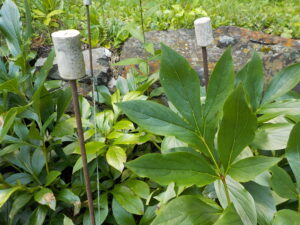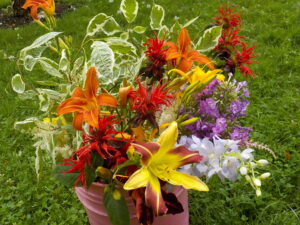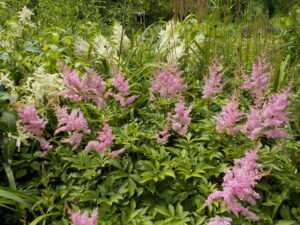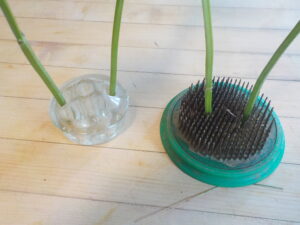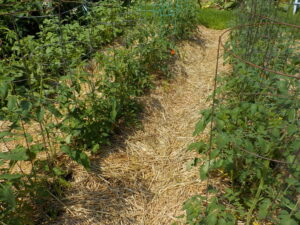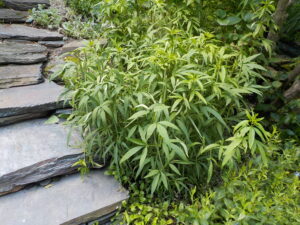Pick Today? Pick Tomorrow? Pick Next Week?
Posted on Saturday, July 29, 2023 · Leave a Comment
Those of us who grow vegetables are faced with many questions each year: will there be a late frost that will harm our tomatoes and peppers if we plant them on Memorial Day weekend? Is it time to harvest garlic now, since they produced their scapes early this year? When should we harvest broccoli– now, with heads still fairly small – or wait till they get bigger? Will the sun finally prevail and give all our veggies a big boost after all this rain?

The vegetable garden is soggy at best
We have seen more rain than usual – much more. Even a quick shower results in standing water in the walkways between my mounded raised beds. But in addition to the excess water, plants aren’t getting their usual allotment of sunshine. They need sun – strong, bright sun – to grow and produce fruits and leaves. The lack of sunshine is what is causing smaller veggies, yellowed leaves, and later ripening.
Is it time to harvest garlic yet? After the plants send up those curly stems we call “scapes”, it is generally fine to harvest garlic. Traditionally I pull mine in mid- to late-August. But it’s important to pull them at the right time, not sooner or later than needed.
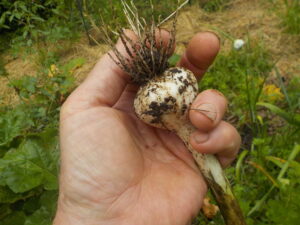
This garlic is smaller than I would expect, but the skin is strong and the others can continue to grow
Here’s what I do: I start by groping my garlic: I slip my hand into the soil and feel how big the bulbs are. I don’t pull them if they’re tiny. But to be on the safe side, I pull a few and look at the skin over the cloves. I want the skins to be strong and tight for good storage. If they are breaking down (due to all the rain), I pull my garlic. If not, I let them keep growing, but check them often.
What about potatoes? My advice is to wait. Yes, you will have some small potatoes as soon as they have blossomed. But I wait much longer than that to harvest mine, as I want big spuds. When leaves start to yellow and die back, then I dig them all. In the meantime, I slip my hand into the soil (without disturbing the plants) and grab a few “new” potatoes for a special treat.
Even though a healthy broccoli plant will produce more food from its side shoots than the main head, some of my plants are small and yellowed from lack of sun. I am pulling the feeble ones and planting a late crop of lettuce by seed in the space.

Brussel sprouts plants should be much bigger by now
My Brussels sprouts plants are also much smaller than normal this year. Fortunately, they will continue to grow until the end of October, or even later. If we get sunshine soon, they should recover. My normal advice is to cut the tops of the plants off on Labor Day weekend so that the plants don’t keep growing taller but instead send their energy into producing big “sprouts”. This year I’ll be lucky if they have stalks at all. So I will wait and see – and I accept that my harvest might be small or non-existent.
Carrots love the rain, and are growing nicely. We thinned them in early July and are keeping them well weeded. Still, little sunshine means they can’t bulk up as they would in a normal year.
Onions are ready to harvest when their tops flop over. Pull the onions, even if small, and allow them to dry for a week or so in a shady, breezy spot.
One bright spot in the garden this year is celery. I don’t usually grow it, as in the past mine has been tough to chew and a magnet for snails and slugs. This year I planted six plants, and although the stalks are not yet thick, the plants are big and so far have not seemed to attract pests. I ate a stalk, and it is tougher than store-bought. But tasty.
I usually grow celeriac instead of celery, and I did start some from seed indoors. Celeriac is also called celery root, and has a big bulb that grows above the soil surface. It keeps in the refrigerator for up to 6 months, and when added in a soup or stew, has the same celery flavor. This year –with little sun? The bulbs are not showing yet.
All this rain inspired me to grow watercress! I got seeds, and the packet says plant in wet soil, preferably in a shady area. I have that. I only did that recently, but the plants have sprouted and seem happy.
The Cornish Fair is always on the third weekend of August and has competitions for everything: who can throw an ax most accurately, who can produce the best strawberry jam – and much more. For me it is a time to compete in the vegetable and flower categories in the gym of the school. Tomatoes generally are ripe by then, but this year -who knows?
Even though I have been picking off the many yellowed leaves on my tomato plants, they are still far behind their usual selves. Do pick off the yellow leaves – they will only spread fungal disease. But only do so when the leaves are dry – if they ever are!
I heard that a study at Harvard found that people who eat a cup of ice cream every day live longer than those that do not. I couldn’t find this study on-line, but have my own theory: People who are happy live longer. If eating ice cream makes you happy, have some! Me? I think the study should have been focused on home-grown tomatoes and potatoes and garlic fresh from the garden. I know they keep me happy – and probably living longer than most!
Henry is an organic
gardener, and an optimist. He believes the summer will turn sunny with moderate rain. Reach him at
henry.homeyer@comcast.net if you want to dispute that.
Sal, of Blueberry Fame, Is Getting Old
Posted on Tuesday, July 25, 2023 · Leave a Comment
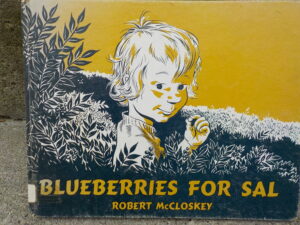
Blueberries for Sal, a classic story,..
Have you ever wondered what would happen after a story ends? I have. The children’s book “Blueberries for Sal” came out in 1948 and has been a hit for 75 years. If Sal was four years old in the book, she must be pushing 80. I imagine she went to the University of Maine and got a degree in teaching. She probably married her college sweetie at age 24, and taught for six years before deciding to start a family. I bet she makes a mean blueberry pie.
The key to a great blueberry pie, in my opinion, is to let the blueberries dominate the flavors, not sugar. Pick a recipe, and mix the ingredients using less sugar than recommended. Maybe half, if it seems like a lot. Or if your recipe uses just a half a cup for six cups of berries, it’s probably fine. Add cinnamon, but more is not better. Sometimes I like a little cardamom.
The best berries for a pie are those you picked yourself. Even better are those you grew yourself. I’m picking blueberries now, and have some tips on how to get a good crop.
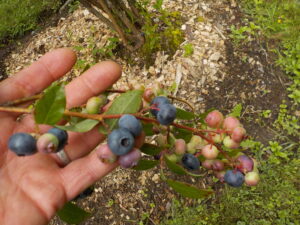
Not all berries ripen at once, even in a cluster
Paul Franklin and his wife Nancy own Riverbend Farm, a self-pick orchard with apples, pears, pumpkins – and 1600 blueberry plants in Plainfield, NH. Paul once told me that there are just three things to get right if you want lots of blueberries: proper soil pH, proper soil pH, and proper soil pH. That’s right, if you don’t have very acidic soil for your berries, you can still have nice bushes, but without proper soil pH, you will only get a few.
For most of us, a simple soil test done with a kit you buy at the garden center or hardware store will show that our soil is around 6.0 or 6.5 if not adjusted. But blueberries want a pH of 4.5 to 5.5 which is much, much more acidic than that. The scale is logarithmic, meaning each change in a number multiplies the acidity 10-fold. So a pH of 5.5 is 10 times more acidic than a pH of 6.5 and 4.5 is 100 times more acidic.
How do you adjust pH? Buy soil acidifier or agricultural sulfur and sprinkle it on the surface of the soil. If you have a thick layer of mulch to keep down the weeds, pull it back, then add your acidifier. Follow the directions on the bag as to how much to add once you know your soil pH. It may take 2 to 3 years to drop the soil pH to the proper level. And doing it now won’t affect this year’s crop.
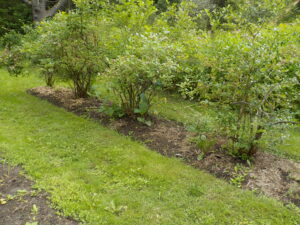
Blueberry bushes do best in a row running east-west
What else should you do? Give your bushes room to grow. I did a single row and spaced the bushes 6 to 7 feet apart. But they are a little crowded now, 20-some years later. If were doing it again, I’d space them farther apart. It’s best to run your row east-west rather than north–south to avoid one plant shading another. Full sun is best, but six hours of sun is adequate.
Blueberries like moisture, but don’t plant them in soggy soil. Also avoid the top of a sunny, sandy hillside. I have mine not far from my brook, and they have done very well. When planting, mix in some duff from under evergreen trees because it will help acidify the soil and will also add fungi that encourage good growth. Pine needles make a great mulch if you have some.
Blueberries do not like weeds, so do a good job of pulling out the grasses and weeds in the place you plant your berries – before you plant. And then add a good thick layer of wood chips around the plants to discourage weeds in the future.
Blueberries are pollinated by bees. And although some varieties are labelled “self-pollinating” it’s always bests to plant several bushes and at least two different varieties.
There is a terrible alien pest that has arrived in most parts of New England, the spotted-winged drosophila. This is an Asian fruit fly that lays eggs in good fruit, as opposed to other fruit flies which only attack over-ripe fruit. In a matter of days, blueberries can go from healthy to mushy and full of larvae. If you cut open a berry that has been infected, you will see the small larvae. At present there is no organic method for controlling them other than covering your bushes with a fine mesh too small for the fruit flies to reach the fruit.
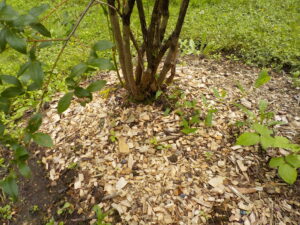
Wood chips make a good mulch
If you are planting blueberries now, choose bushes that produce their fruit early in the season and avoid plants that mature later in the summer. Why? Some growers are finding that the fruit flies don’t show up early in the summer, so they are getting crops of early blueberries before the pest shows up. And buy the biggest bushes you can find – or afford. Blueberries are relatively slow-growing in our climate.
Birds can be a problem, too. I no longer cover my bushes with netting – I found too many birds got caught in the mesh, so now we just share. And unless you get a flock of cedar waxwings (which are voracious berry eaters), most birds don’t seem to be greedy. Last summer I enjoyed watching bluebirds feeding their second set of chicks with my berries.
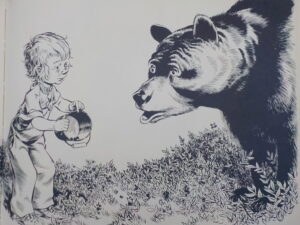
Sal had a close encounter with a bear
I bet Sal (who had a close encounter with a mother bear in that wonderful book) had three kids, two girls and a boy. By now those kids would range in age 43 to 48, so her grandkids are either teenagers or in college. But I bet they all visit her in blueberry season for her wonderful pie. Her mother’s recipe, no doubt. Pie is always a good lure for grandkids, especially blueberry pie.
Henry is the author of 4
gardening books and is a lifelong organic
gardener. Reach him by e-mail at
henry.homeyer@comcast.net.
I grow so many flowers because they give me pleasure to look at them. And even though I spend a lot of time in the garden, I spend more time indoors than out, so I cut stems of annuals, perennials and flowering woodies and arrange them in vases. I want flowers on the kitchen counter, the dining room table, the desk I write at, the bedroom, the bathroom – in fact, every flat surface in the house.
Let’s look at some basics of preparing and arranging flowers. When is the best time to pick flowers? Pick in the cool of the morning, especially if the day will be hot. The stems are full of water and carbohydrates and should feel full, not limp. Bring along a clean container so that as you wander around picking flowers their stems are well submerged. Instead of picking flowers just before dinner with company, try to pick them before going to work in the morning.
It’s best to let your freshly cut flowers stay in the bucket of water for an hour before you arrange them. Cut the stems on a 45 degree angle using floral shears, or your by-pass pruners if they are sharp. Scissors made for cutting paper are not good for flowers, so you may want to buy a dedicated pair of floral shears.
Because of capillary action, water in hollow stems will be sucked up the stem a little as soon as you cut them. So you need to recut about ¾ of an inch of each stem and place it in a vase right away. Otherwise an air bubble may inhibit water take-up.
Florists selling fancy roses or other expensive flowers generally provide a packet of “flower preservative”. But you can buy that stuff or make your own for your homegrown flowers. In a quart of water add a teaspoon of sugar, a teaspoon of household bleach and 2 teaspoons of lemon or lime juice. I learned long ago to drop a couple of copper pennies in a vase with a bunch of tulips to help keep the buds closed longer and have seen it work. Failing that, just change the water every two or three days, and trim off a little of each stem.
The height of the vase is important. I’ve read “expert” advice recommending different ratios for the height of the vase to the length of the flowers ranging from flowers being 1.5 times the vase height, up to 3 times the vase height.
There are devices called frogs that can be placed in a bowl or big vase to hold flowers in place. They consist of a piece of heavy metal with sharp, upward-pointing pins that allow you to stab the flower stems and hold them in place. Glass frogs also exist that have divots in a chunk of glass where a stem can be lodged.
What is blooming now that will look good in a vase? I love delphinium, astillbe, daylilies, roses, bee balm, phlox and Shasta daisies. All will last well in a vase, and provide plenty of height for a tall vase.
We just finished the peony season with the Itoh peonies lasting well past normal herbaceous peonies. They are the result of crossing tree peonies with regular peonies. Mine, called Garden Treasure, produced 30 or more 5-inch diameter blossoms that last very well in a vase.
Arranging flowers is an art form we can all enjoy. You don’t need training or expertise. Just pick what you like, and arrange them in a vase, or even in a tall water glass. Give flowers to an aging uncle or a friend with a sprained knee. Everyone loves the gift of flowers. And be sure to put some on your dinner table tonight.

